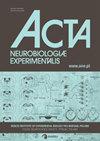专业舞蹈培训对姿势摇摆特征的影响
IF 1.4
4区 医学
Q4 NEUROSCIENCES
引用次数: 0
摘要
人体直立姿势的稳定性决定了动作的幅度和动态。因此,舞者的动作种类和质量主要取决于姿势控制的效率。这一点在专业舞蹈训练中尤为重要,因为专业舞蹈训练应侧重于塑造最佳的动作-姿势互动。为了更深入地了解这一问题,我们以一所芭蕾舞学校七年级的 16 名女学生为对象,分析了训练对安静姿态时姿势摇摆特征的影响,并与体型和年龄匹配的中学生组进行了比较。在睁眼(EO)和闭眼(EC)安静站立时,记录了 25.6 秒的压力中心轨迹。姿势控制的评估基于新的归一化摇摆参数,包括摇摆矢量(SV)、摇摆前胸(AP)和内外侧(ML)方向指数(DIAP 和 DIML)以及摇摆比率(SRAP 和 SRML)。研究结果表明,视觉对芭蕾舞学生的姿势稳定性控制有重要作用,它似乎可以补偿与训练有关的关节活动度变化和腿部肌肉活动范围的改变。在对照组中,EC 站姿的 SV 振幅只增加了 18%,而在芭蕾舞学生中,相同条件下的 SV 振幅增加了 72%。在完全控制站立姿势的情况下(EO 测试),与训练相关的腿部肌肉力量的增加使舞者能够以较小的努力保持平衡,SRAP 减少 21% 即为证明。此外,舞者在接受 EC 测试时,前胸摇摆增加了 12%,同时内外侧摇摆减少。DIAP/DIML 和 SV 方位角都记录了由此产生的姿势控制不对称变化。总之,我们对姿势摇摆的新分析似乎是监测训练效果以及儿童和青少年姿势控制发展正确过程的有用工具。本文章由计算机程序翻译,如有差异,请以英文原文为准。
Impact of professional dance training on characteristics of postural sway
The stability of human upright posture determines the range and dynamics of movements performed. Consequently, the repertoire and quality of the movements performed by a dancer are mainly determined by the efficiency of postural control. This is of particular importance in professional dance training that should focus on shaping optimal movement‑posture interaction. To get a deeper insight into this problem, the impact of the training on postural sway characteristics during quiet stance was analyzed in 16 female students in the seventh grade of a ballet school and compared with the size‑ and age‑matched group of secondary school students. Center of pressure trajectories were recorded for 25.6 s while standing quiet with eyes open (EO) and then with eyes closed (EC). The assessment of postural control was based on novel normalized sway parameters including sway vector (SV), sway anteroposterior (AP) and mediolateral (ML) directional indices (DIAP and DIML), and sway ratios (SRAP and SRML). The results document a significant contribution of vision to postural stability control in ballet students, which seems to compensate for training‑related changes in joint mobility and altered activity ranges of the legs’ muscles. In the control group standing with EC, SV amplitude increased only by 18% whereas in the ballet students tested in the same conditions, the increase exceeded 72%. Under full control of standing posture (EO test), the training‑related increase of leg muscle forces allows dancers to maintain balance with lesser effort as documented here by 21% reduced SRAP. Additionally, the dancers while tested with their EC exhibited a 12% increase in the anteroposterior sway with a concomitant reduction of the mediolateral sway. The resulting changes in the postural control asymmetry were documented by both DIAP/DIML and SV azimuth. In conclusion, our novel analysis of postural sway seems a useful tool in monitoring the effects of trainingas well as the proper course of postural control development in children and adolescents.
求助全文
通过发布文献求助,成功后即可免费获取论文全文。
去求助
来源期刊
CiteScore
2.20
自引率
7.10%
发文量
40
审稿时长
>12 weeks
期刊介绍:
Acta Neurobiologiae Experimentalis (ISSN: 0065-1400 (print), eISSN: 1689-0035) covers all aspects of neuroscience, from molecular and cellular neurobiology of the nervous system, through cellular and systems electrophysiology, brain imaging, functional and comparative neuroanatomy, development and evolution of the nervous system, behavior and neuropsychology to brain aging and pathology, including neuroinformatics and modeling.

 求助内容:
求助内容: 应助结果提醒方式:
应助结果提醒方式:


